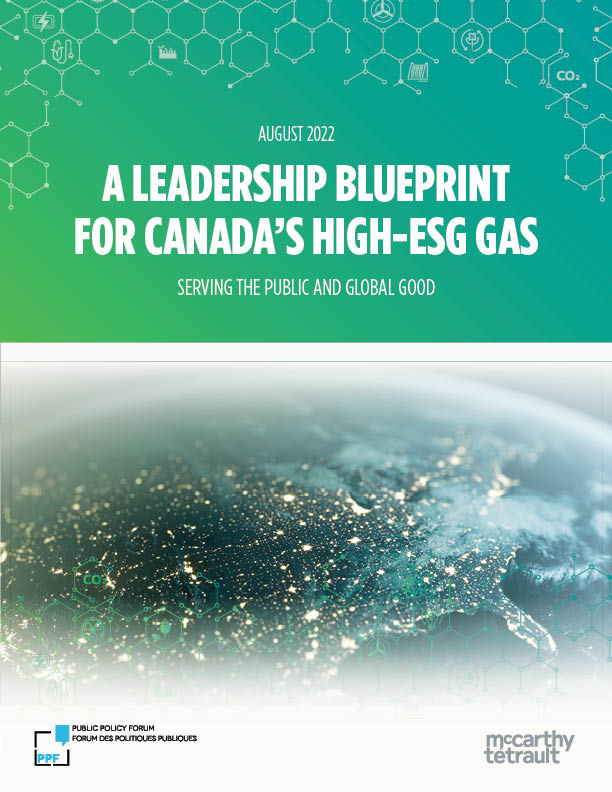
A Leadership Blueprint for Canada’s High-ESG Gas
Serving the Public and Global GoodFOREWORD
Climate actions, despite their obvious importance, aren’t as easily done, as said. That should be clear enough in looking at the stresses Europe, despite its best intentions, began experiencing even before the invasion of Ukraine. Like many others, Europe, in its quest to be a leader in emissions reductions, failed to pay adequate attention to security and affordability issues. Now, the trade-offs have become impossible to ignore. Europe is scrambling to rectify its inattention to energy transition complexity through a two-track strategy: an attempt to further accelerate the growth of renewables, while urgently scouring the earth for new sources of gas, restoring gas exploration in the North Sea, breaking ground on new LNG import facilities, recommissioning closed coal plants and perhaps nuclear facilities, and planning for the very real possibility of energy rationing.
Among other things, the winter of 2022 will be remembered for stacking an energy crisis onto the climate crisis. The message to all is that energy transitions are messy affairs and that policymakers can never afford to lose sight of the broad menu of risks to citizens and consumers forced to live in the here and now.
For Canada, it is often said that being both a supplier and consumer of fossil fuels – and one with highly differentiated regional economies – makes the pursuit of sound climate and energy policies all the more complex. To achieve our domestic objectives of meeting or exceeding our 2030 Paris targets and reaching net-zero emissions by 2050, our choices must be environmentally, economically and politically sustainable over decades, not just years. Canadians are, by their nature, internationalists. They also abhor disorder. As such, they expect to contribute to global climate solutions, so long as they aren’t subjected to European-style disruptions.
For too long, Canada’s unusual energy circumstances have been viewed as a negative. In fact, our blend of resource wealth, technological prowess and good global citizenship provide a unique opportunity for Canada to help other nations with their energy transitions while serving our national interests. As a high-ESG (Environmental, Social and Governance) energy exporter, there is no preordained contradiction between Canada’s national public good and the global good. Achieving both simply takes some policy imagination – and not a massive amount.
Natural gas provides a case in point. Canadians might be surprised to learn that our natural gas is among the cleanest in the world in terms of carbon content. As will be demonstrated in this paper, this juxtaposition of abundant and lower-carbon natural gas provides an opening to thrive at home and to matter abroad.
The word ‘ambition’ is often – and appropriately – attached to ever-more, far-reaching climate actions. Ambition also must be applied to the ability to execute on national and global objectives, which, in a democracy, also means the ability to carry the public without undue division. When confronted with what is considered a “wicked problem,” policymakers often remind themselves that “the perfect cannot be the enemy of the good.” This is very much true for the future of Canada’s natural gas. Canada’s ability to play an outsized role depends on possessing and communicating clear goals and implementing them pragmatically.
In March 2022, the Public Policy Forum hosted a “High-Level Gas Summit” to explore the opportunities and obstacles presented by Canada’s natural gas gifts, and weigh whether and how to further develop a resource that remains in high demand at home and abroad. The Gas Summit served as one of several key inputs into this paper, which builds on the intellectual foundations laid out in PPF’s February 2022 Leadership Blueprint on Canada’s Net-Zero Energy Transition. The Public Policy Forum operates under a principle we call Inclusion to Conclusion. It means making sure a range of interests and perspectives (thinkers, doers and deciders) with mutual interests confront the trade-offs inherent in any policy decision (Inclusion) before settling on the options with the most promise of making for a better future (Conclusion).
In the case of the Gas Summit, viewpoints were offered by government officials, environmentalists, investors, geopolitical strategists, public opinion professionals, Indigenous leaders, natural gas distributors, industrial users, proponents of liquefied natural gas (LNG) and of hydrogen, importers of Canadian energy and others. Many of the participants have been involved in PPF’s wider Energy Future Forum. It has heard from representatives based in Europe, Asia, the United States and Canada and has debated and come to conclusions on such matters as carbon capture and removal, nature-based solutions, the decarbonization of fossil fuels, electrification, Indigenous ownership, sustainable finance and low-carbon exports.
We are grateful to everyone for their spirited contribution to the Gas Summit and other Energy Future Forum activities. We trust they will see the discussions in which they’ve been involved reflected in the thinking behind this paper. I am particularly grateful to our partners at McCarthy Tétrault, Wayne Wouters and Dave Nikolejsin, for their co-leadership in this process, Kim Henderson for chairing our gas working group and co-authoring this paper, Steve Carr, Janet Annesley and Dale Eisler for their contributions to the drafts, and to a large number of my colleagues at the Public Policy Forum, including Darren Touch, David Campbell, Nina Newman, Masha Kennedy, Brian Bohunicky and Hannah Yakobi.
There is no room to compromise on the scourge of climate change. Yet, there are better and worse and safer and riskier routes to our collective future. Identifying these is the point of PPF’s Energy Blueprint series.
Edward Greenspon
President & CEO
Public Policy Forum
This report is produced in partnership with McCarthy Tétrault.









